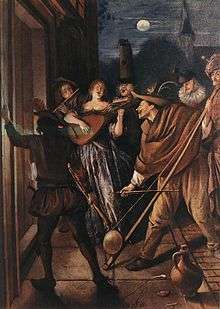Bladder fiddle
The bladder fiddle (also known as bumbass or poispil) is a folk instrument used throughout Europe. The instrument was a simple large monochord made with a long stick, a thick gut string, and a pig's bladder. It is bowed with either a notched stick or a horsehair bow. It is known under different names; in Germany it was called the bumbass, in France the basse de Flandre, and in England a drone, "drone and string" or bladder fiddle. In Germany sometimes a bell or cymbal was added to the top for decoration or additional sound. In England it was used by traveling musicians.[1]

The drum, made of an inflated animal bladder or taut animal hide, is secured to the centre of a long stick. A thick string is then attached to each end of the stick, securing the bladder. It is usually played standing upright by drawing the bow over the string.
A related instrument was preserved amongst the Pennsylvania Dutch (German immigrant to the rural Eastern United States), and is known as a boom-ba.
Latin America
In Venezuela, the bladder fiddle is known as "marimba, tarimba, guarumba, guasdua, and carangano".[2]
References
- Baines
- David M. Guss (2000). The Festive State: Race, Ethnicity, and Nationalism as Cultural Performance. University of California Press. pp. 188–. ISBN 978-0-520-92486-4.
- Anthony C. Baines. "Bumbass", Grove Music Online, ed. L. Macy (accessed August 20, 2006), grovemusic.com (subscription access).